Visiting The Taj Mahal And Agra (2023): Don’t Go Before Reading This
One of the new seven wonders of the world, the Taj Mahal is truly majestic and awe-inspiring.
This ultimate guide will cover all of the do’s and don’ts for visiting the Taj Mahal and other Agra attractions as well as transportation, accommodation, ticketing and tour guide information, 10 scams to avoid, how to get that bucket list shot without any tourists in the background, and additional tips and recommendations that other guides to visiting the Taj Mahal and Agra don’t cover!

Table of Contents
History Of The Taj Mahal
The Taj Mahal in the Agra district of Uttar Pradesh, India is a grand mausoleum that was built by Mughal emperor Shah Jahan in memory of his favorite wife whom he referred to as Mumtaz Mahal.
Born as Arjumand Bantu Begum, the emperor conferred the title Mumtaz Mahal to her, meaning the crown of the palace. After Mumtaz died while giving birth to their 14th child, the emperor began his plan to build the Taj Mahal.
Taj means crown and Mahal means palace, thus meaning the palace of the crown.
Both the emperor and Mumtaz lie in rest in the basement of the Taj Mahal. The mausoleum and surrounding gardens, mosque, guest house, main gateway, outer courtyard, and cloisters were built between 1631 and 1653.
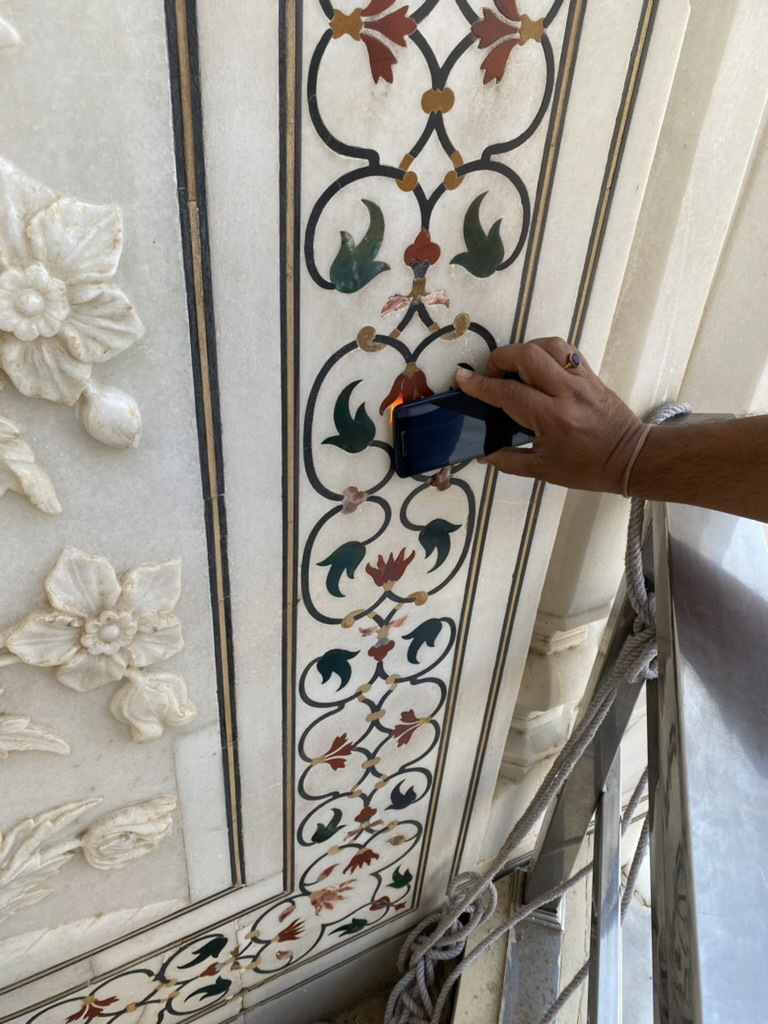
The Taj Mahal is considered the greatest Indo-Islamic architectural and artistic achievement in the world. It is constructed of white marble in perfect symmetry with intricate relief work and inlay floral art composed of precious and semi-precious stones, including mother of pearl which glistens when the sun hits.
The Taj Mahal takes on different appearances based on the time of day, the position of the sun, and the color and clearness of the sky as light penetrates the white marble, thus it is always changing.
The four minarets flanking the mausoleum are actually not completely straight, but rather thoughtfully constructed and angled slightly outwards in case of an earthquake to prevent them from falling onto the mausoleum.
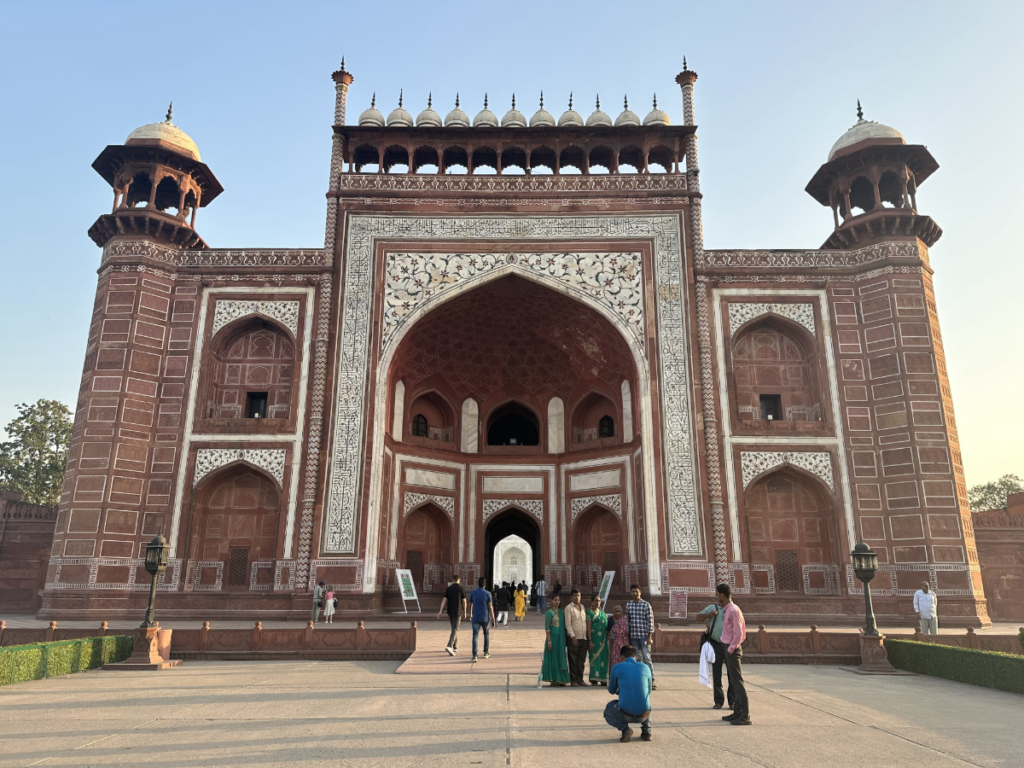
The main gate was designed like a veil to hide the beauty of the Taj Mahal. As you approach the entrance, the arch perfectly frames the center domed structure and as you pass through, quickly reveals the breathtaking expanse of the structure and stunning grounds.
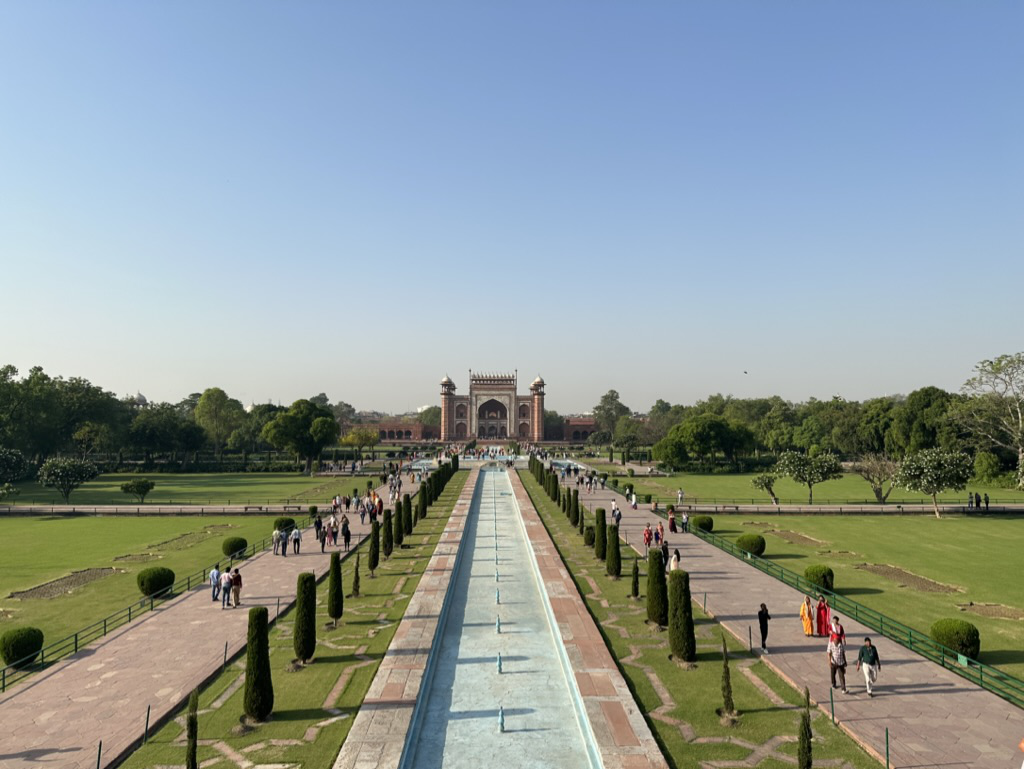
The condition of the Taj Mahal is meticulously maintained through a variety of efforts, including a buffer zone surrounding the masterpiece where no electric vehicles are permitted as well as special cleaning practices to maintain the vibrance of the marble.
Visitors must go barefoot or wear shoe covers before ascending the stairs to the mausoleum to reduce deterioration.
The surrounding water features are also drained frequently (our guide estimated approximately bi-weekly) to remove debris and maintain pristine beauty.
A broader Taj Trapezium Zone (TTZ) of 10,400 kilometers was instated in 1996, banning coal/coke industries and allowing only natural gas in order to reduce the effects of pollution within the designated radium. The TTZ protects 40 monuments including the three UNESCO World Heritage Sites of the Taj Mahal, Agra Fort, and Fatehpur Sikri.
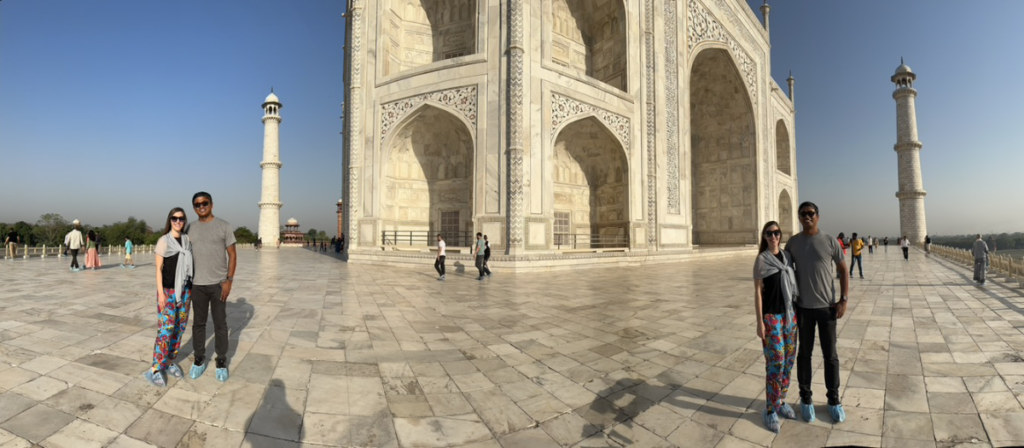
Although repairs and conservation work continue to be carried out, the complex remains completely authentic to the time of construction. And in fact, the descendants of the original laborers who were brought to construct the Taj Mahal (some 22,000+ people) are the laborers that continue to complete the repairs and conservation work today!
Visiting The Taj Mahal
Ticketing Information
Daytime Visits
For daytime visits, you can either choose to book a forenoon ticket or an afternoon ticket. The forenoon ticket allows access to the Taj Mahal complex from 30 minutes before sunrise until 12 PM and the afternoon ticket allows access after 12 PM until close.
Ticketing windows close 45 minutes before sunset and the complex closes 30 minutes before sunset.
Good Dimes tip: visit at sunrise for beautiful lighting, to beat the heat, and to beat the crowds!
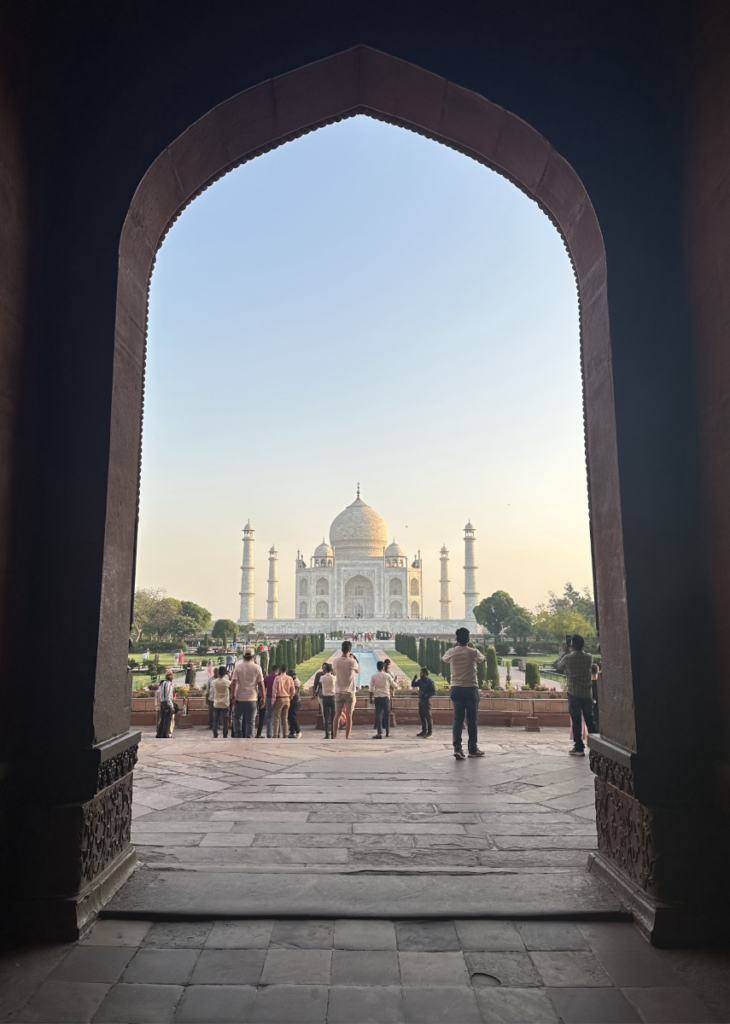
If you book online, you’ll save 5-50 rupees and also prevent the headache of waiting in line and wasting precious moments, especially if you’re trying to make it in time for sunrise.
The website is misleading and makes it sound as if you’re only able to book tickets online, however, the ticket counter was open when we went. I assume this is an outdated Covid procedure and that the website hasn’t been updated.
The 2023 prices are as follows:
- Indian Citizens and OCI (Overseas Citizens of India)= 45 rupees (online), 50 rupees (in person)
- Foreigner/NRI (Non-resident Indian)= 1050 rupees (online), 1100 (in person)
- SAARC (South Asian Association for Regional Cooperation)/BIMSTEC (Bay of Bengal Initiative for Multi-Sectoral Technical and Economic Cooperation)= 540 (in person)
- There is no entry fee for children under 15 years of age (domestic and foreigner)
- If you want to enter the mausoleum, there’s an additional charge of 200 rupees.
Good Dimes tip: If you’re an Indian Citizen, OCI card holder, SAARC, or BIMSTEC, be sure to bring identification that proves your nationality or your status, otherwise you won’t be granted the discounted rate.
The Taj Mahal is closed on Fridays so be sure you plan your visit on another day!
Nighttime Visits
You can also visit at night time five days a month during the full moon (two days before the full moon, on the full moon, and two days after the full moon). Night viewing occurs between 8:30 PM and 12:30 AM in 8 groups of 50 people max for periods of 30 minutes. Night viewing is closed every Friday and during the month of Ramzan/Ramadan.
Night viewing pricing (2023):
- Indian Citizens and OCI (Overseas Citizens of India)= 510 rupees
- Foreigner= 750 rupees
- Children 3-15 years of age (domestic and foreigner)= 500 rupees
Tickets are available one day before the date of night viewing from the office of Archaeological Survey of India (ASI) at:
- Address: 22, Mall Road, Agra between 10 AM and 6 PM
- Phone: +91 0562 – 2227261
- Email: circleagra.asi@gov.in
Sunrise or Sunset Cruise
Another cool way to see the Taj Mahal is to take a 15-20 minute sunrise or sunset cruise along the Yamuna River for an unobstructed view of the back of the Taj Mahal. Don’t substitute this for a trip inside the gates of the Taj Mahal, but it would be a great addition to round out your experience in Agra.
Summer morning sunrise departures are at 6:00, 6:30, 7:00, 7:30, and 8:00 AM. Summer evening sunset departures are at 4:30, 5:00, 5:30, and 6:00 PM. Winter morning sunrise departures are at 7:00, 7:30, 8:00, and 8:30 PM. Winter evening sunset departures are at 4:00, 4:30, 5:00, and 5:30 PM.
An alternative sunset viewpoint is from the Mehtab Bagh (garden complex directly across the Yamuna River).
Tour Guide Service For Visiting The Taj Mahal
If you pay for a tour guide anywhere in the world, this is one of the places to do it! Seriously, do not skip this! Our guide completely transformed our experience – we learned SO much from him. The Taj Mahal is such an impressive historical place that was so very intricately designed. Without a guide, you’ll miss out on 90% of the experience.
In addition to what you’ll learn, you’ll also have a built-in photographer. This proved to be an extremely valuable bonus, especially since tripods are not allowed inside the complex. Boy, am I glad we weren’t stuck with a bunch of selfies and solo shots!
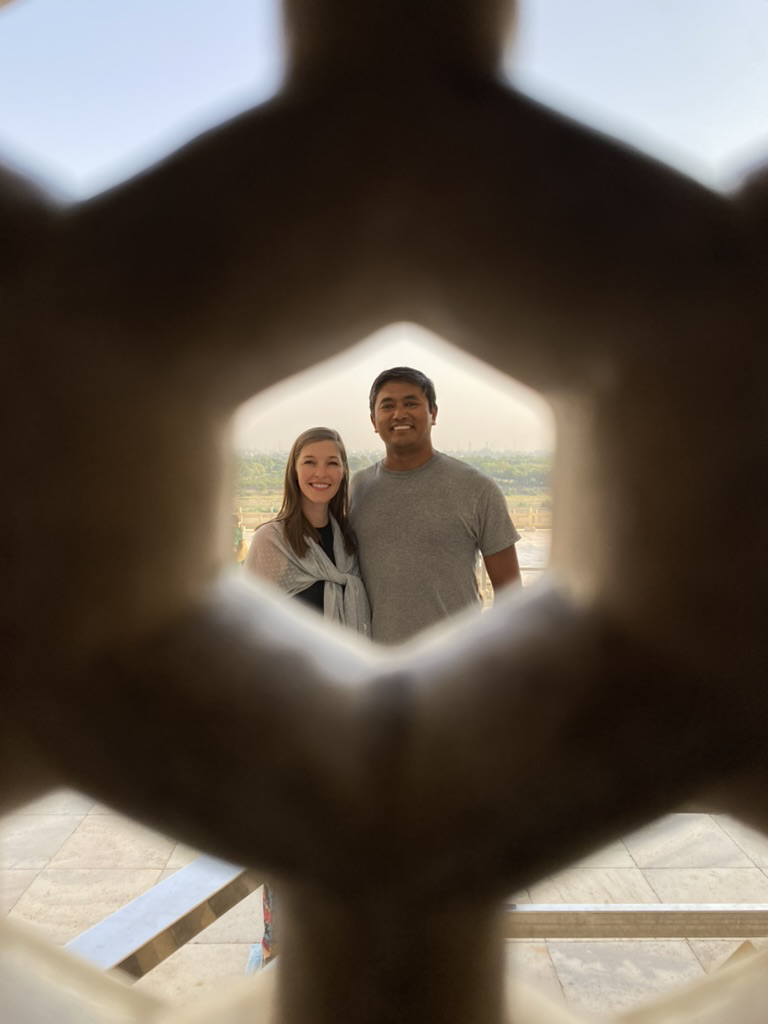
Our guide instructed us in photo locations and poses and he was continually asking to take photos for us, so we actually got some great pictures as a couple without feeling as though we were burdening someone else.
Book your tour of the Taj Mahal below through Get Your Guide!
The 2023 standard half-day rate for a tour guide licensed by the Ministry of Tourism for the Taj Mahal is 1,800 rupees. The standardized rates are posted on a large sign at the Taj Eastern Gate parking lot where the electric golf carts depart from. We hired our guide directly from this area on the morning of our visit after he approached us offering his services.
Good Dimes tip: My advice is to hire your tour guide through Get Your Guide to reduce the risk of scams. However, stay guarded during your tour to prevent being subjected to any of the 10 common scams highlighted further down in this post.
Do’s And Don’ts When Visiting The Taj Mahal
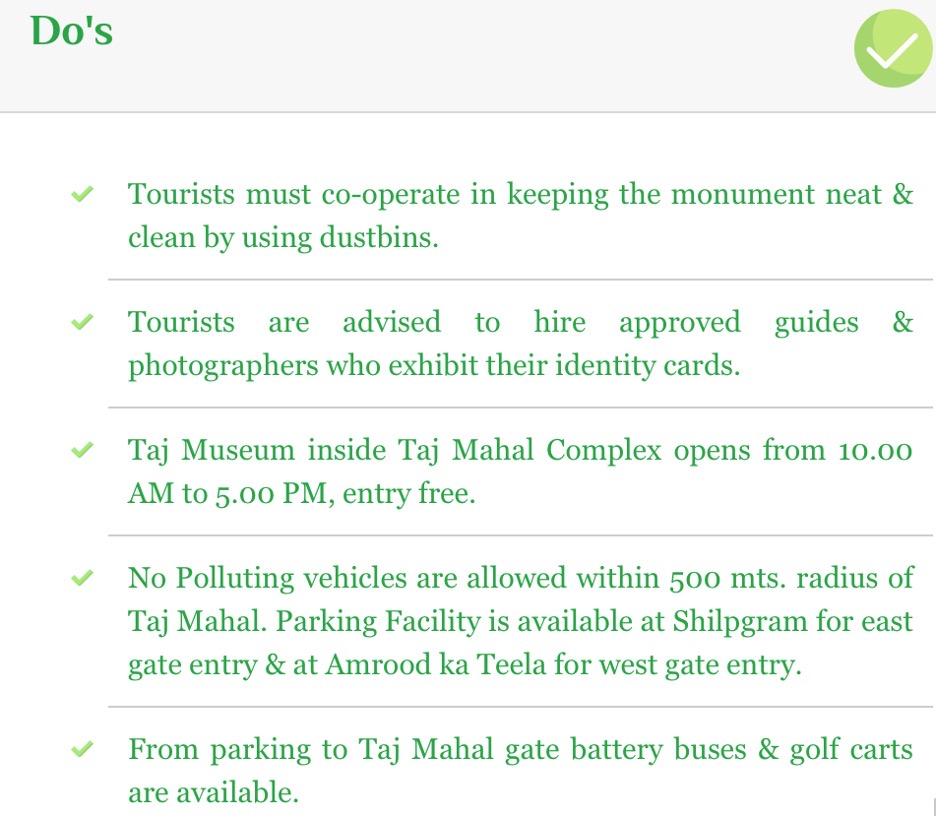
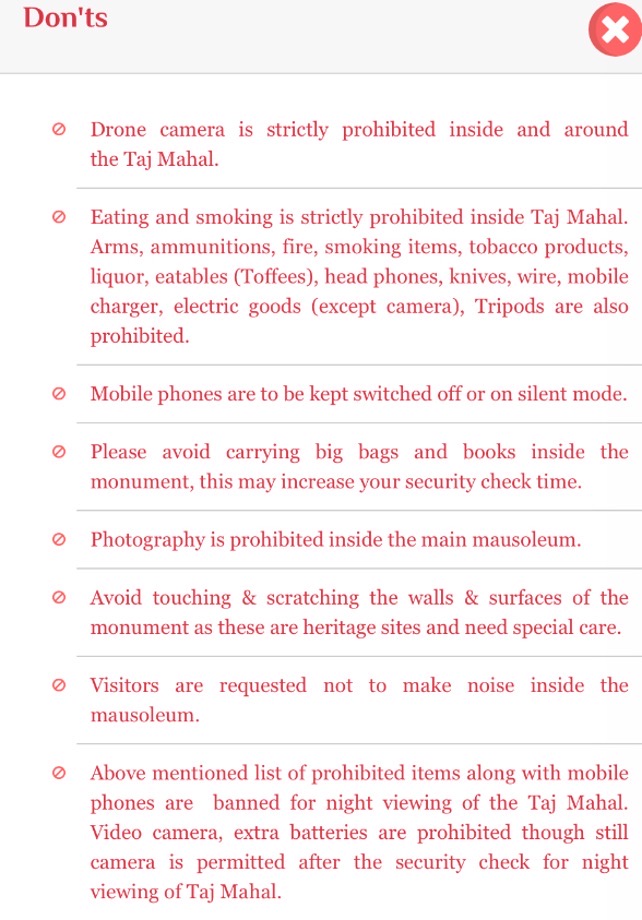
Although not mentioned on the official website, our tour guide told us we weren’t allowed to bring cosmetics including any sunscreen, bug spray, or other topicals. Since I had sunscreen, bug spray, and lip balm in my bag, he arranged for us to store them at his friend’s shop (very clever) instead of storing them in the cloakroom as he initially mentioned.
After searching online after the fact, I wasn’t able to find anywhere that mentions this restriction. However, if I were you, I would either apply everything before you leave your accommodation and leave it all behind to avoid any extra hassle or confirm with your accommodation/pre-hired tour guide ahead of time.
How To Get That Bucket List Shot When Visiting The Taj Mahal Without Swarms Of Tourists In The Background
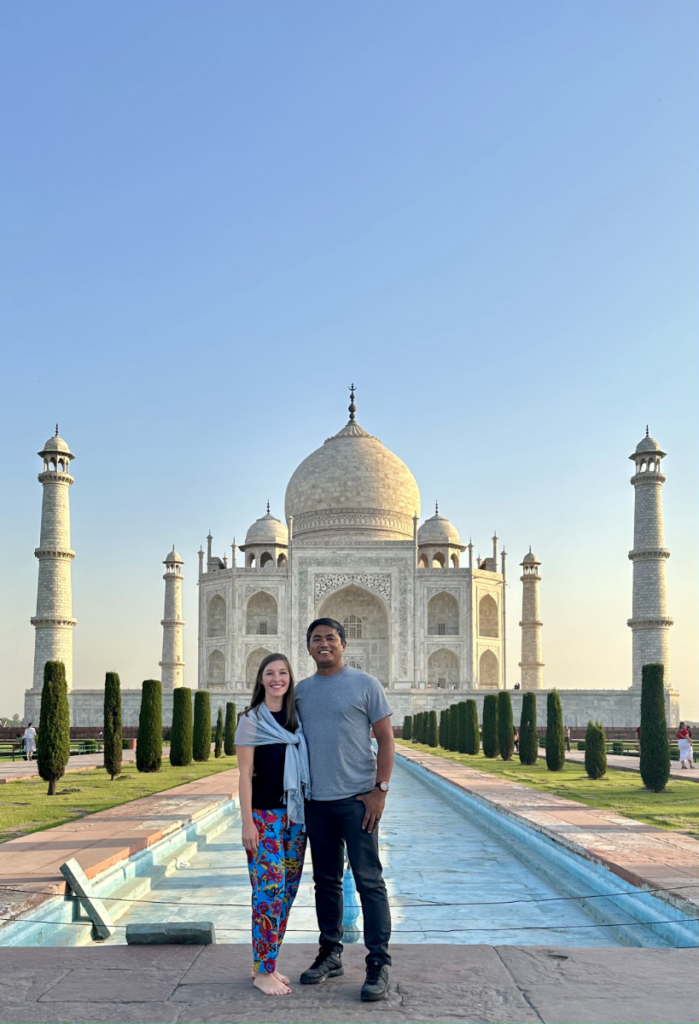
☀️ Time of year – Visit during the off-season! The high season is approximately from October – March. July marks the peak low season, however, it’s also the rainy season, so heed this time of year with caution and consider adding an extra day or two to your time in Agra in case of foul weather.
Some sources state that the average number of daily visitors in July is ~20,000, whereas the average number of daily visitors in December and January surpasses 100,000 with peak visitors on Christmas Eve and New Year’s Eve surpassing 200,000!
We visited in May, and while the temperature reached above 100 degrees Fahrenheit at the peak heat of the day, it was still comfortable to visit at sunrise and a couple of hours following. Avoid public holidays.
📆 Time of week – Avoid weekends and Thursdays if possible. The Taj Mahal is closed every Friday, so we were informed that tourists peak on Thursdays to squeeze in their visit before the Friday closure and the weekend.
🕑 Time of day – Arrive when the gates open to beat the crowds, the heat, and to get great lighting for photos. The gates open 30 minutes before sunrise. We actually arrived about 45 minutes after sunrise, but since we visited in low season and on a weekday, we were still able to beat the crowds. Of course, this is a matter of luck based on the number of people who happen to visit on the same day as you.
📍Exact location – The money shot is about halfway between the entry gate and the mausoleum. Follow the path towards the mausoleum until you reach the platform that separates the two water features (or lack thereof as it was in our case since the water features had been drained for cleaning).
If there’s already a line, step in line and wait your turn. If there’s no line, even better! Stand between the platform and the mausoleum just in front of the water feature that leads to the mausoleum.
When we visited, there were several other locations where we were able to get unobstructed photos without anyone else, however, this is the view that’s most iconic and quite pleasing to the eye.
📐Angle – If you visit when it’s crowded, be sure the person who’s taking your picture is standing at the same level as you or crouches down to accentuate your height in relation to other people.
🤲🏼 An extra set of hands – Having a tour guide was critical for us. Our guide was continually offering to take pictures for us and instructed us in specific photo op locations and poses. Additionally, he had a photographic eye, so our pictures actually turned out good. No bad angles or missing body parts!
Be sure to arrange your tour guide in advance so that you don’t waste any time the day of, especially if you are trying to catch the sunrise.
Book your guide tour for the Taj Mahal below through Get Your Guide!
How To Get To Agra
You can reach Agra, home of the Taj Mahal, by air, rail, or road.
- Air – India Airlines operates daily flights to Agra airport.
- Train – An expansive network of trains connects Agra with the rest of the country. The main station is Agra Cantt (Agra Cantonment), however, there are two additional stations of Raja-ki-Mandi and Agra Fort.
- Road – There are regular bus services between Agra and a number of important cities, including Delhi, Jaipur, Mathura, Fatehpur Sikri, etc. Additionally, you can hire a private car transfer or taxi service between Delhi and Agra.
We took the train between Delhi and Agra. Our train fare from Delhi to Agra on the Intercity Express was 2,472 rupees for 2 people and, in fact, it was a slow train despite the name “express” (3 hours and 50 minutes). Our train fare from Agra to Delhi on the Gatimaan Express train was 2,562 rupees for 2 people (1 hour 45 minutes).
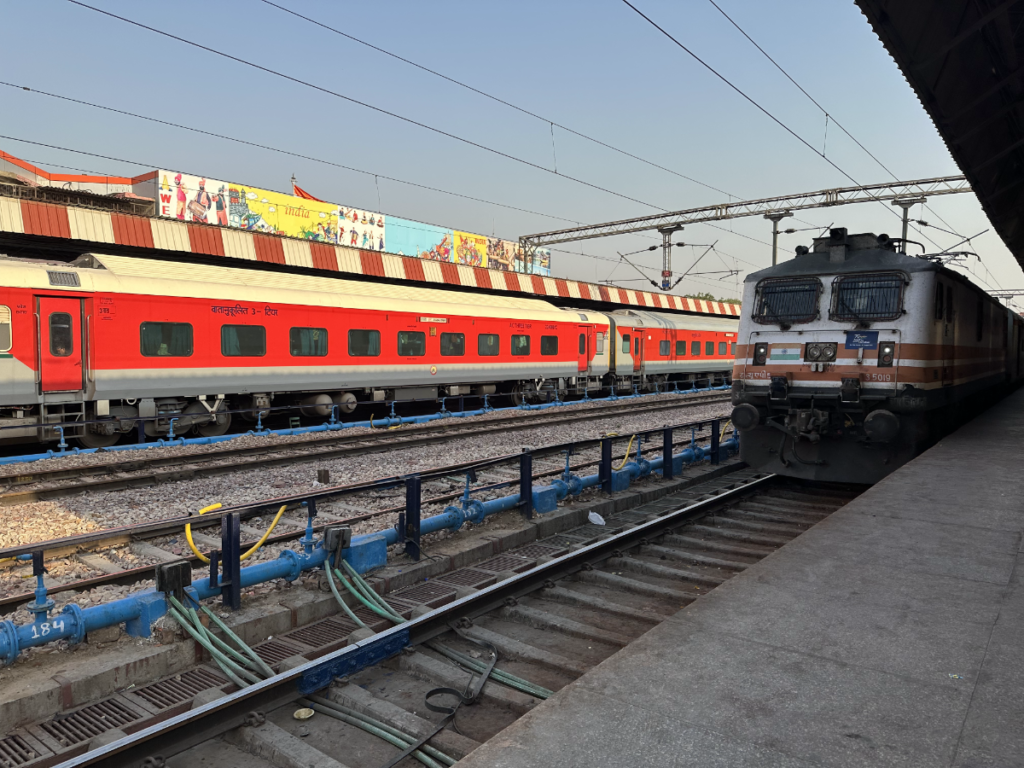
I highly recommend taking the fast train since they’re so similar in price in order to maximize your adventure time. And definitely don’t skimp on the AC!
Book your train to Agra below through 12Go!
There are non-AC compartments but you definitely won’t regret paying a little extra for the added comfort. When we booked, unfortunately, there was no availability on the fast train from Delhi to Agra in the compartment of our choice, so we ended up on the slow train.
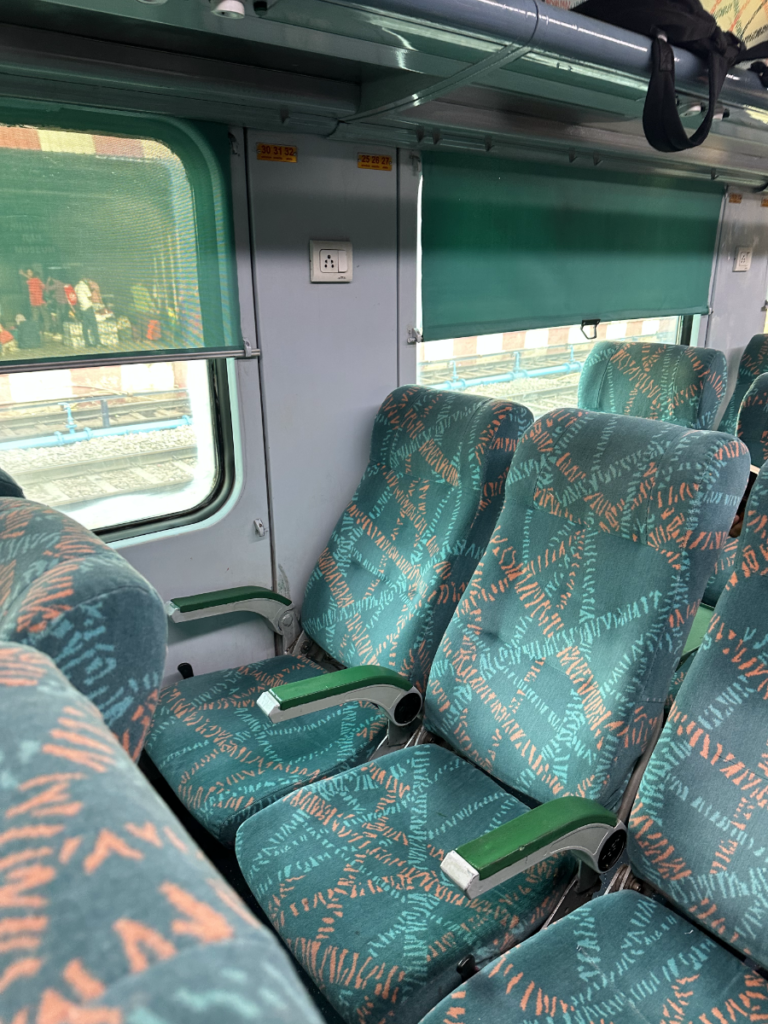
If you take the train, keep your bug spray handy. Even though we booked an AC cabin, there were lots of mosquitos in our compartment from Delhi to Agra. They mostly dissipated once the train started moving but we continued to get visits every so often. Delhi is in a malaria zone so take extra precautions, especially if you’re not taking an anti-malarial medication.
Once you reach Agra, you can use Uber for local transport to hire auto rickshaws or cars.
Where To Stay In Agra
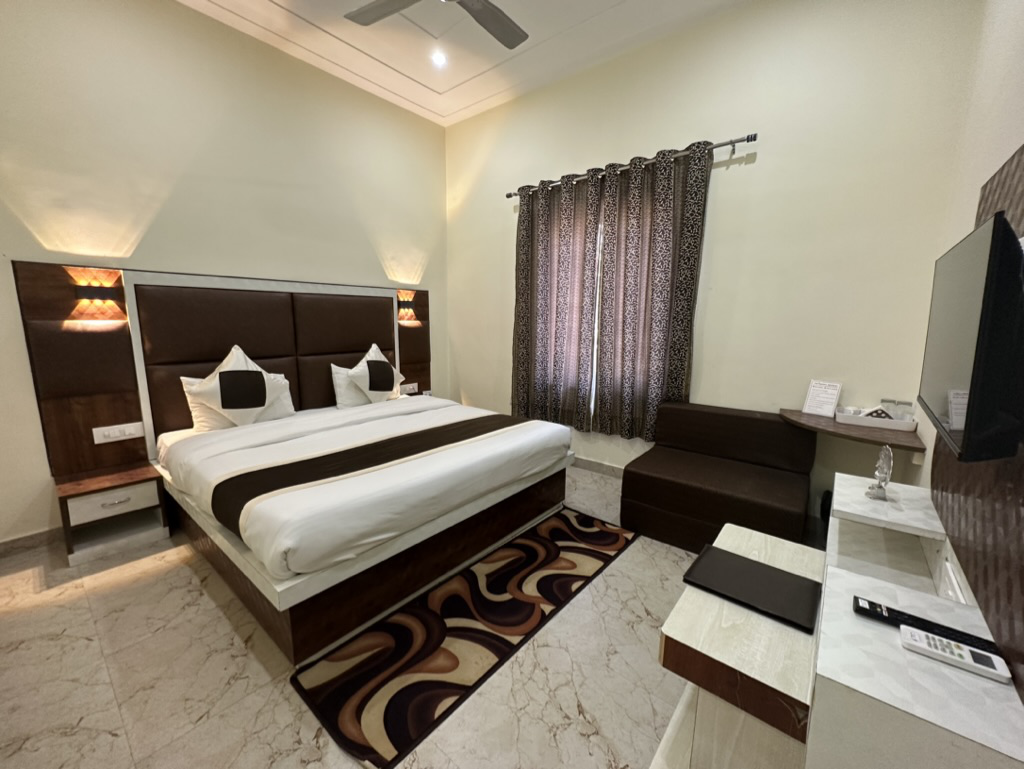
I cannot recommend the Orchid Retreat enough for your accommodation in Agra when visiting the Taj Mahal. Vikrant and his family were the kindest hosts and truly went above and beyond to extend the utmost hospitality during our stay.
Our room was spacious and spotless and was equipped with AC and a fan, a very comfortable king bed, a locking closet, shower shoes, and strong wifi. The restaurant is open for breakfast, lunch, and dinner and Vikrant’s wife is a fabulous cook, so there is no need to eat outside.
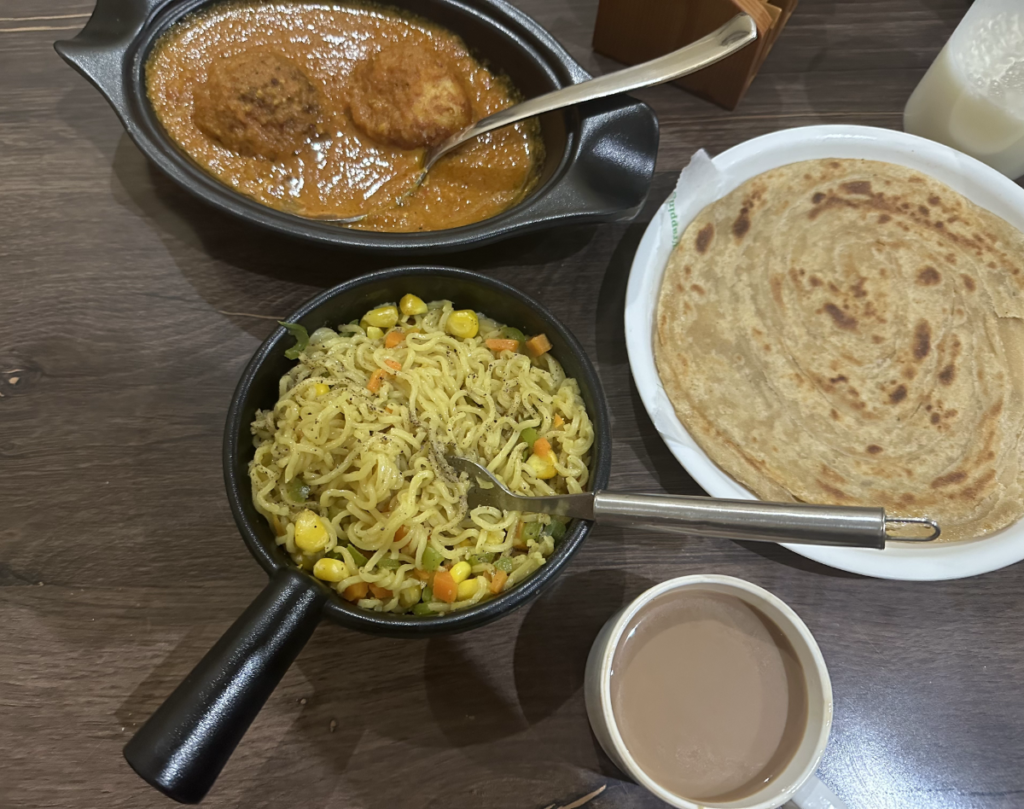
The orchid retreat also offers currency exchange through a Forex dealer, travel packages & car rental, tour guide, laundry, yoga classes, cooking classes, and souvenir purchases with free pickup and drop facility from pre-selected shops.
Since we visited during the low season and the retreat was not fully booked, Vikrant allowed us a late checkout of whatever time we wanted. We ended up staying until just after 5 PM since our train departed in the evening. This allowed us to seek refuge from the heat during the day, rest, shower, eat, and get some work done.
The Orchid Retreat is located about two blocks outside of the buffer zone of the east gate entrance (about 2 minutes walking) where electric vehicles are prevented from entering, thus you really can’t find a better location when visiting the Taj Mahal. Additionally, the west gate is the main entrance, so entering through the east gate may help you to avoid some of the crowd and allow a faster entry into the Taj Mahal!
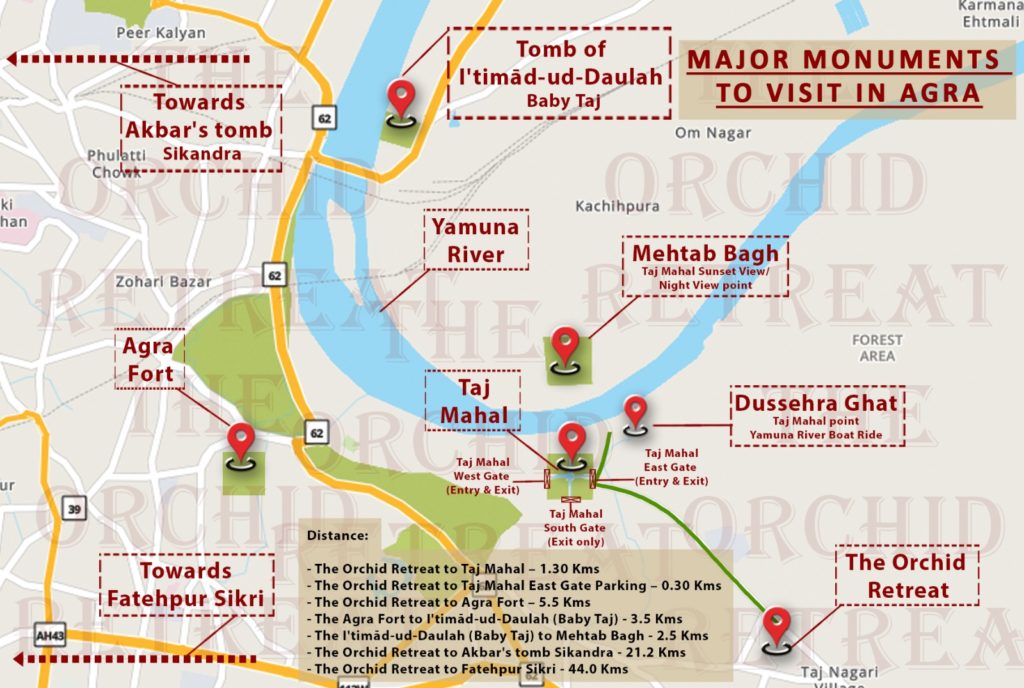
Electric golf carts are located just inside the buffer zone and provide transport to the entrance of the Taj Mahal. Transport on the electric golf cart is included with a foreigner’s ticket. Otherwise, it costs 20 rupees per person per way. If you opt out of the electric golf cart, the walk to the entrance is about 15 minutes. The tour guides are also located where the electric golf carts depart from and they will ride with you on the golf cart if you choose to take a guide.
10 Scams To Avoid
Unfortunately, scams are plentiful in Agra! Here’s what you need to know in order to avoid some of the most common scams in Agra.
- Transportation – Order your transportation on Uber or Ola or have your accommodation arrange reliable transportation for you. Uber and Ola both have car and auto-rickshaw options. Avoid taxis at the train station, if possible, and drivers that approach you within the city. Drivers operating outside of Uber and Ola may take you to their friend’s shop and try to get you to purchase something in order to earn a commission or worse, they may take you to the wrong location and then extort you for money to get you to your destination.
- Tour Guides – If you opt for a tour guide (anywhere in the world but especially in Agra), be sure you get a registered government tour guide who’s wearing their badge with their credentials. Some guides may even try to fake their identification! The safest option is to arrange your tour guide through Get Your Guide in order to avoid any guide scams!
- Photographers at the Taj Mahal – Apparently the photographers inside the Taj Mahal will quote you an initial price but charge you significantly more in the end. Avoid them altogether and have your tour guide take your pictures for you (if you opt to hire one, which I recommend you do).
- Inside the Taj Mahal Mausoleum – A man stands beside the tombs inside the mausoleum at the Taj Mahal who will illuminate carnelian semi-precious stones and then will call your name which will echo throughout the mausoleum. If you’re interested, you can take him up on this show and tip him 20 rupees or more if you wish. If you’re not interested, try to avoid making eye contact with him, and don’t give him your name. I’ve read reviews that he got aggressive with tourists even when they didn’t ask for the demonstration.
- Souvenirs – You’ll be approached by people holding souvenirs, like magnets and replicas of the Taj Mahal, outside of the Taj Mahal gates. These souvenirs are supposedly priced 2-3x higher than what you’ll pay in government shops or at the airport. Additionally, if someone approaches you with a replica of the Taj Mahal and tells you it’s made of marble, it’s probably made of soap!
- Crystal Shops – Apparently, there are scams at crystal and marble shops near the Taj Mahal. The tour guides will direct you to these shops after your tour because they are getting a commission for bringing tourists to them. Supposedly, the crystal shop will tell you that the crystals are handmade but in reality, they’ll sell you fakes.
- Marble Shops – A trip advisor review I read from 2011 recounted an experience of a tour guide taking the tourist to the “government-approved” marble shop directly across from the admission office. The woman watched a demonstration of the technique used during the construction of the Taj Mahal for carving semi-precious stones inlaid in marble. The shopkeeper also demonstrated how soap scratches and flakes on glass surfaces but marble does not. The tourist decided to purchase a piece of “marble” and double-checked to make sure it was real by doing the scratch test with the item she chose to buy. It was then wrapped in five layers of bubble wrap. When they arrived home, they discovered their piece was made of soap! Apparently, they switched the marble piece out after “proving” it was real. I think my husband and I may have been led to the very same marble shop or a sister shop, as ours was near the Taj Mahal’s entrance. We received the same demonstration described and the same five layers of bubble wrap. However, the marble trivet I chose was wrapped in bubble wrap before our eyes and then handed to us. Our purchase was also quite heavy. We even unwrapped it when we reached my mother-in-law’s house in northeast India. The stones and “marble” were glistening. Because we still had another 5 months of travel ahead of us, we opted to leave the trivet behind with my mother-in-law and pick it up on our next trip back to northeast India. I really hope a big, expensive, glistening bar of soap isn’t waiting to greet us!
- Shoes – A group of YouTubers visited the Jama Masjid AKA the Jama Mosque where you have to remove your shoes prior to entry. When the group came out of the mosque, they were told they had to pay for their shoes despite that not being legitimate. The group took their shoes, kept walking, and nothing happened.
- Count Your Change – This tip is universal, but apparently, especially in Agra, be sure to count your change! The same YouTubers visited Akbar’s Tomb and the attendant at the ticket counter provided the wrong change in return until called out on the situation.
- Additional Filming Fees – While at Akbar’s Tomb, a “security guard” tried to tell the group of YouTubers that they needed a separate ticket to film, however, there was no filming fee listed under the price information at the booking counter.
Good Dimes tip: my best advice is to avoid watching any demonstrations outside of shops or going into any shops near the Taj Mahal in general. It seemed harmless to watch the demonstration and to take a look inside. After all, I wanted to look at the marble. However, once inside, I was undecided and said I wanted to think about it and might come back later. That’s when the bargaining started and “special morning prices” were offered for being the first customer of the day. Be FIRM and if you’re unsure or not interested, be clear that you don’t want to buy anything.
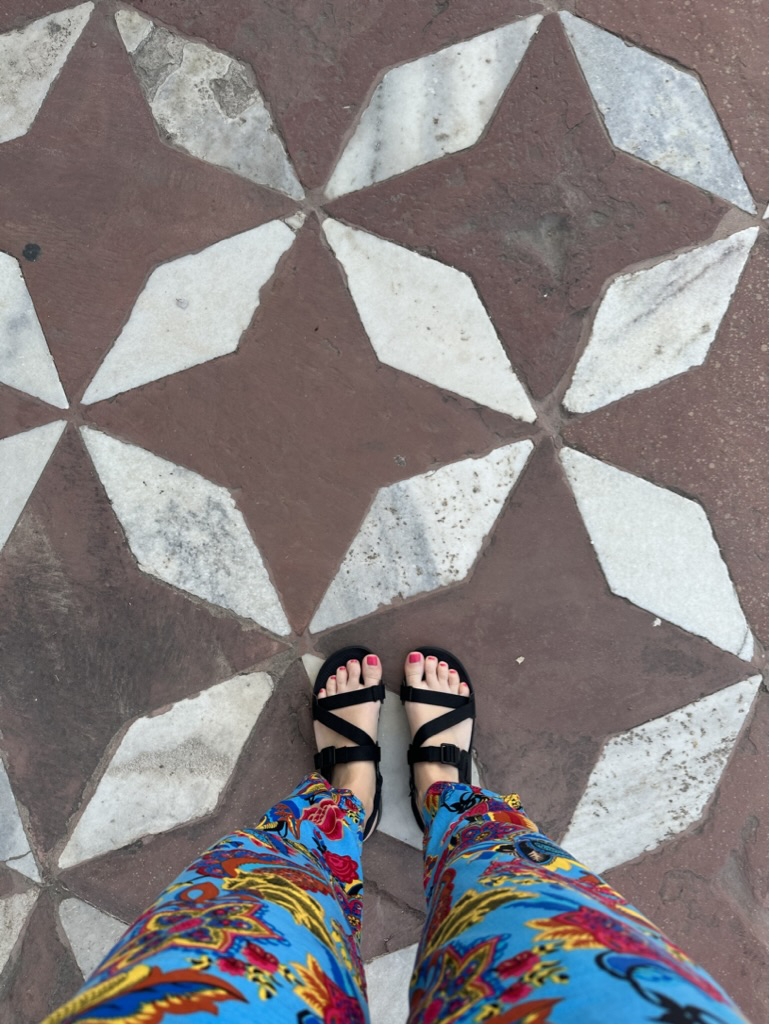
Additional Sites To See In And Around Agra After Visiting The Taj Mahal
Agra Fort
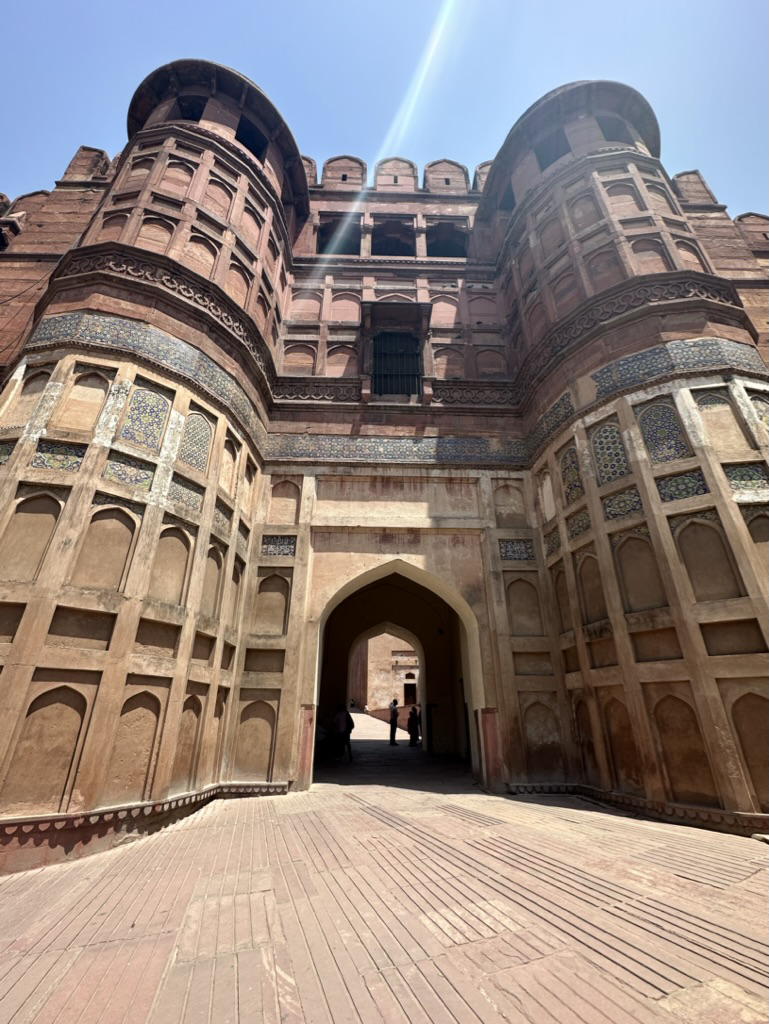
Agra Fort is definitely worth a visit. A UNESCO World Heritage site, it served as the main residence of the emperors of the Mughal Dynasty until 1638 when the capital was moved to Delhi.
Agra Fort is essentially a walled city with many different structures to explore inside, although the majority of the land is currently occupied by the Indian army. It was constructed by some 4,000 laborers and took eight years to build. From Agra Fort, there’s a great view of the Taj Mahal.
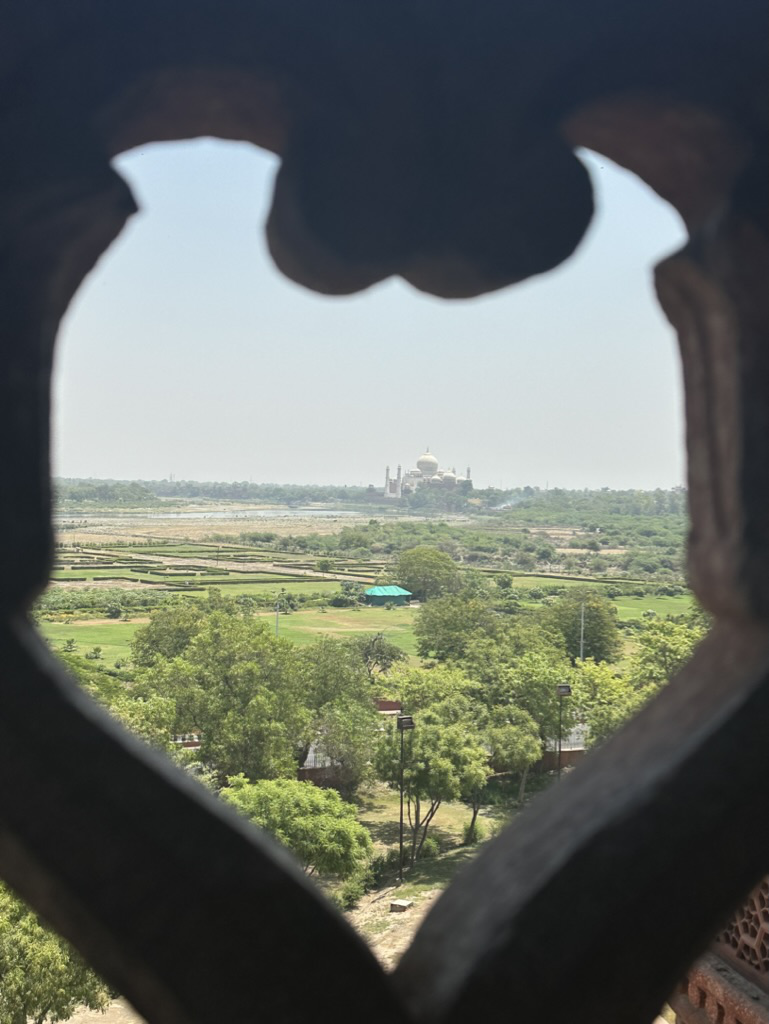
We re-hired our Taj Mahal tour guide for Agra Fort. While we got value out of having a tour guide for Agra Fort, if you’re on a budget, I would recommend only hiring a guide for the Taj Mahal.
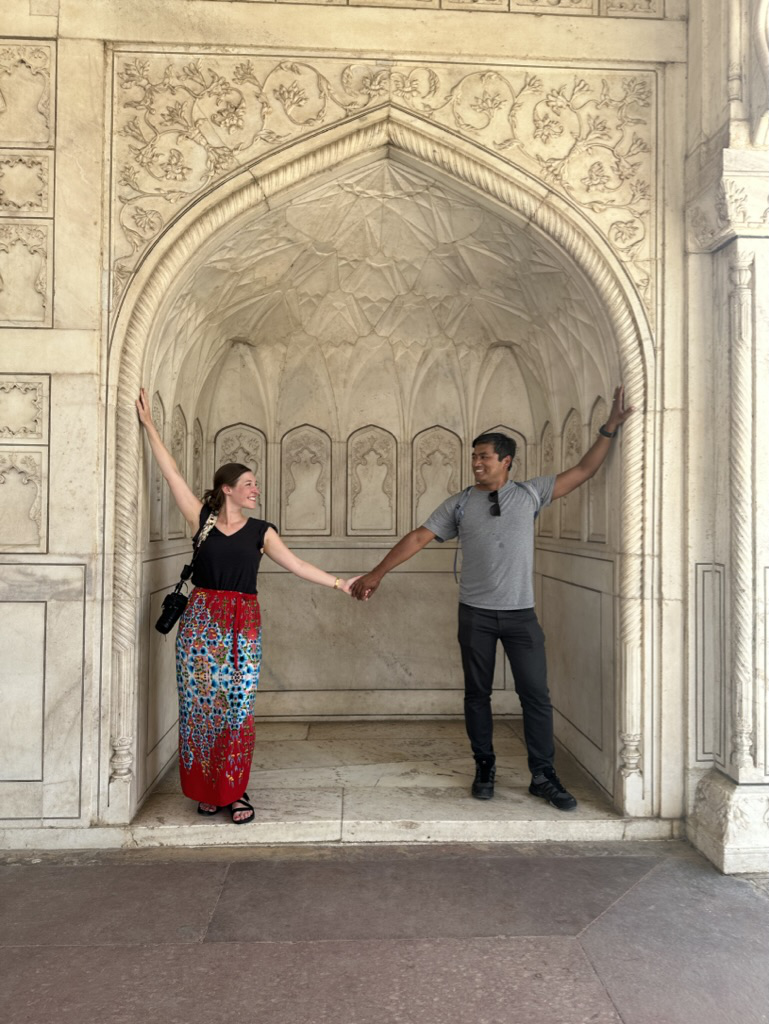
The 2023 prices are as follows:
- Indian Citizen – 40 rupees if purchased online (50 rupees if purchased on-site)
- Foreigner – 550 if purchased online (600 if purchased on-site)
Supposedly if you show proof of purchase of Taj Mahal tickets, you’ll receive a discount when purchasing on-site, however, our tour guide completed the transaction for us at cost.
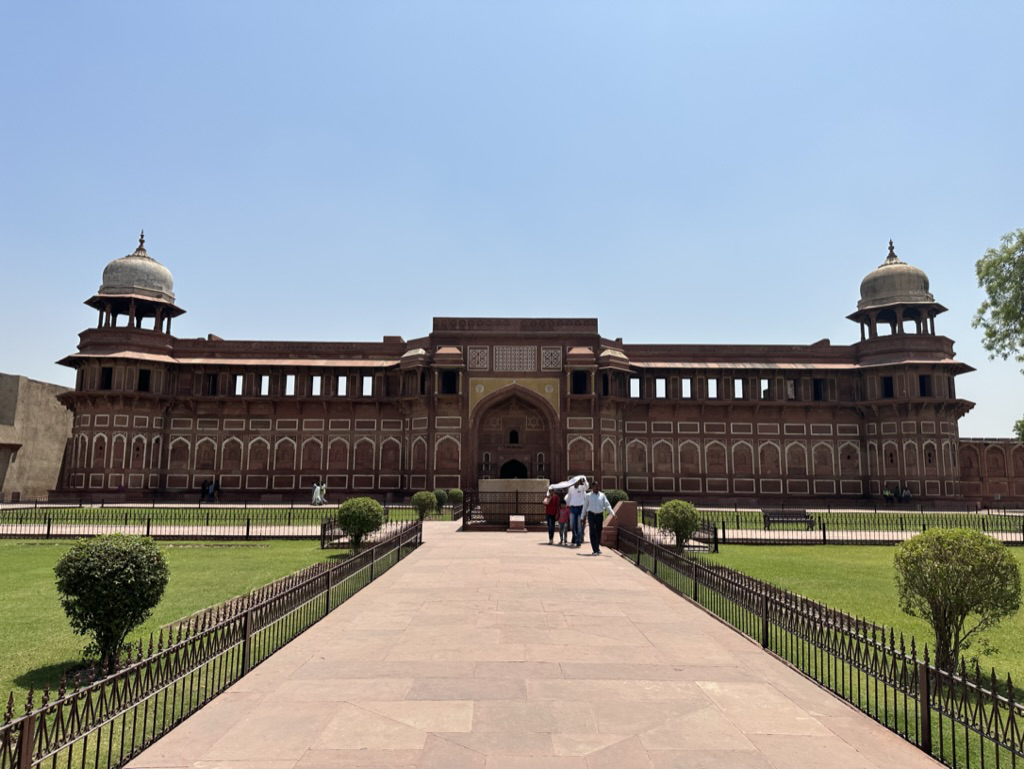
Agra Fort is open from 6 AM – 6 PM (sunrise to sunset) but they also do a light and sound show which happens 30 minutes after sunset in Hindi and immediately following the Hindi show in English. Entrance to the Fort for the light and sound show is less expensive for foreign tourists than for regular admission as it only costs 200 rupees.
The Tomb Of Itimad-Ud-Daula AKA Baby Taj
The tomb of Itimad-Ud-Daula is located near the Taj Mahal and received the nickname “Baby Taj” because it has many architectural and design features that were later incorporated into the construction of the Taj Mahal. Everyone in Agra refers to the mausoleum as “Baby Taj”, so you don’t have to worry about remembering the formal name.
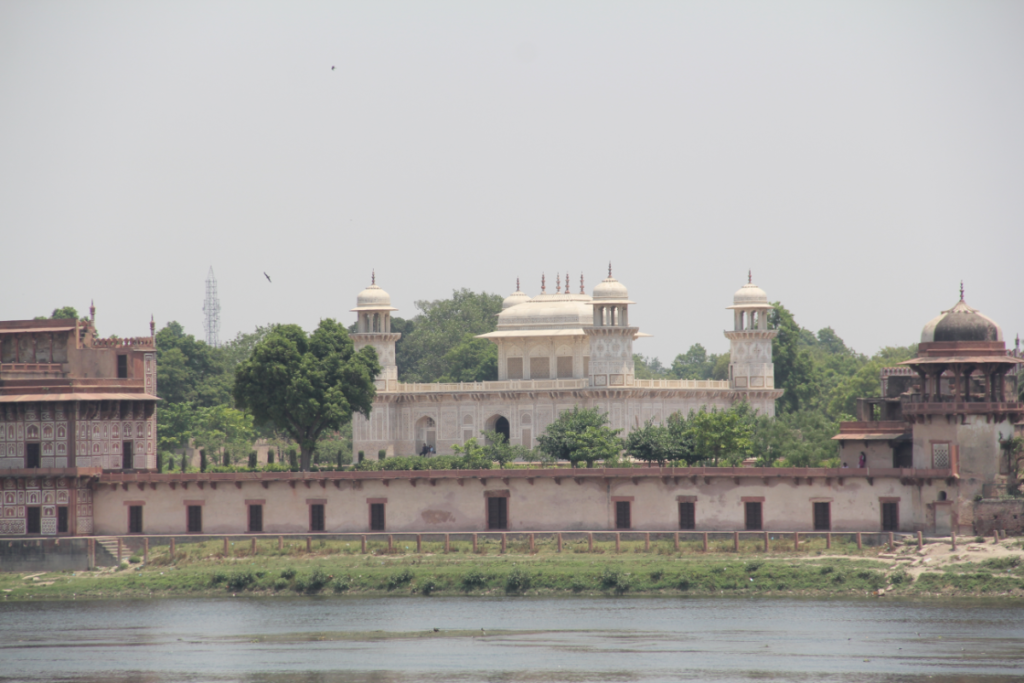
We opted to skip the Baby Taj since we were still quite jet lagged, having arrived from the US less than 48 hours prior. It was also over 100 degrees and, in addition to our fatigue from getting up to see the Taj Mahal at sunrise and heading to Agra Fort afterward, we also had some work to do. However, we still wanted to get a glimpse of the Baby Taj.
The auto-rickshaw driver who picked us up from our guesthouse and transported us to Agra Fort offered to wait for us while we toured the fort without charging a waiting fee. When we completed our tour, he was patiently waiting for us with a smile. We told him we wanted to see the Baby Taj but we didn’t want to pay to go inside, so he told us he would take us to the backside of the Baby Taj. This worked out perfectly, as the view was unobstructed and we were satisfied to be able to see it without it being concealed by a wall.
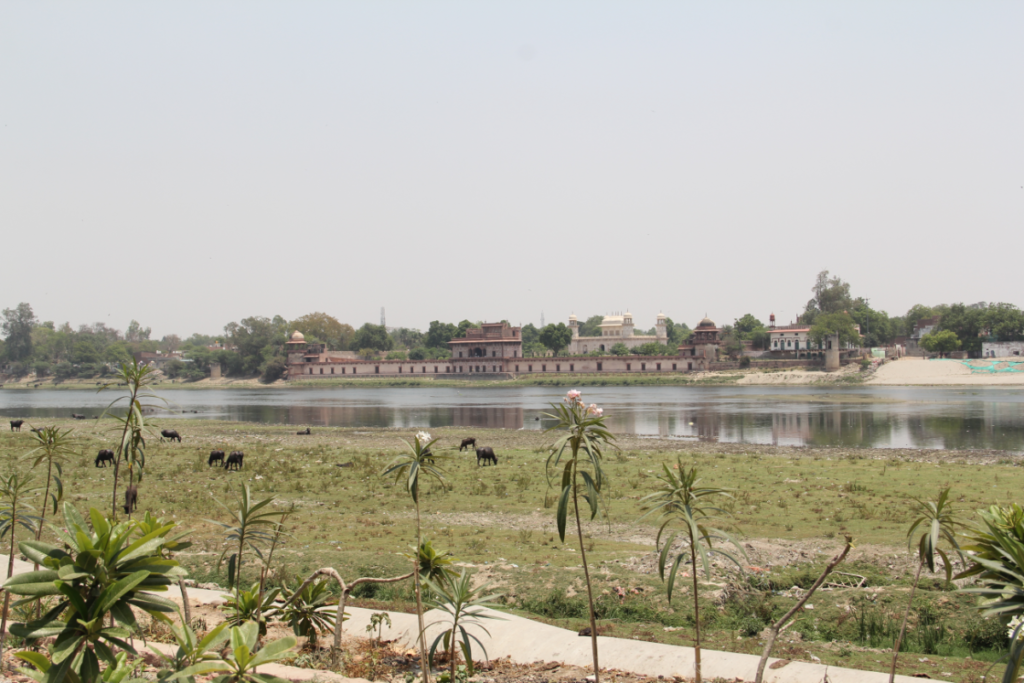
Fatehpur Sikri
Located about 37 kilometers from Agra, Fatehpur Sikri was built by the Mughal emperor Akbar. The city was intended to be his capital, but water shortages required him to abandon the city after construction was completed. Fatehpur Sikri is made predominantly of red sandstone and is a UNESCO world heritage site.
Akbar’s Tomb
Akbar was a Mughal emperor. His tomb is located on 119 acres of land in the town of Sikandra near Agra in Uttar Pradesh, India. The tomb was built between 1605-1613.
Mehtab Bagh
The Mehtab Bagh is a garden complex located on the left bank of the Yamuna River located directly opposite the Taj Mahal. This garden complex was built by Emperor Babur, the founder of the Mughal Dynasty. Mehtab Bagh was the last of 11 parks built by Emperor Babur along the Yamuna River bank. Mehtab Bagh offers a great vantage point for viewing the Taj Mahal.
Ram Bagh AKA Aram Bagh
Ram Bagh is a garden complex by the Mughal emperor Babur. Built in 1528, it is Agra’s oldest garden. It’s located in the midst of a busy market in Agra. Supposedly emperor Babur was temporarily buried in Ram Bagh before being transported to Kabul, Afghanistan.
Mariam’s Tomb
The tomb of Mughal emperor Akbar’s wife Mariam Zamani is built of red sandstone and located 1 kilometer from Akbar’s tomb in Sikandra.
Jama Masjid AKA The Jami Masjid AKA The Jama Mosque AKA The Friday Mosque
The Jama Mosque was built between 1643-1648 and is located in Agra with views of the Red Fort. It is one of the largest mosques in India and was commissioned by the daughter of Mughal emperor Shah Jahan during his reign.
Pricing Table For All Monuments In And Around Agra
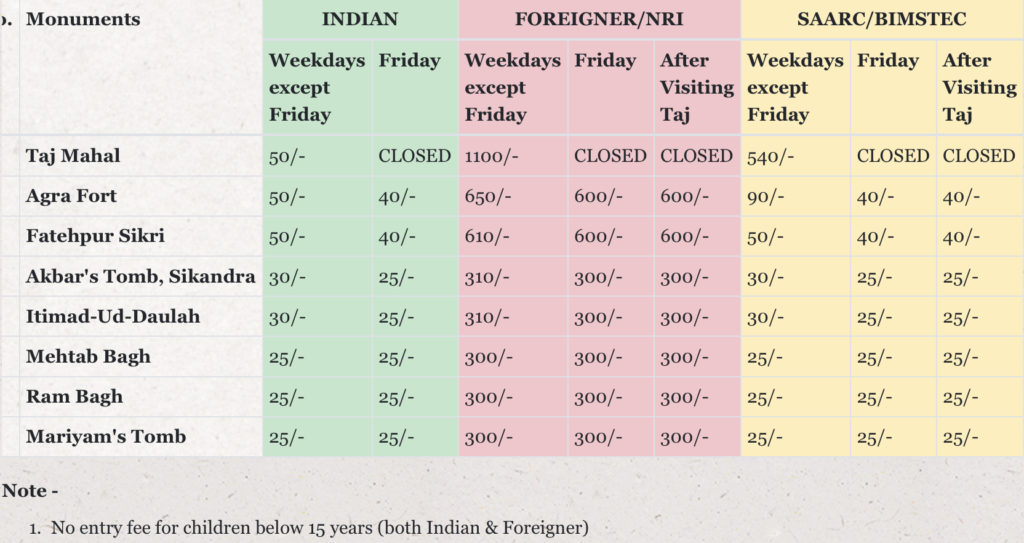
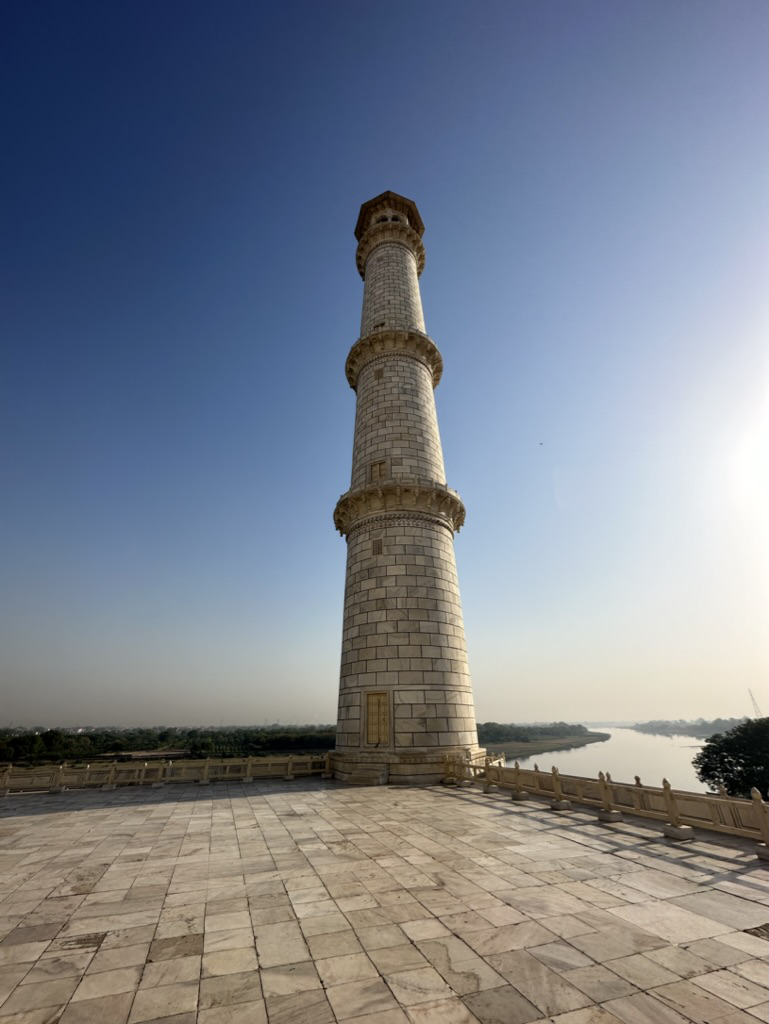
I hope you got a lot of value from this post and feel well-equipped to plan your trip to Agra! If you have any other tips for visiting the Taj Mahal and Agra, let the Good Dimes community know in the comments below.
Looking for more content on India?
→ Check out my post about renting a houseboat in the Kerala Backwaters.

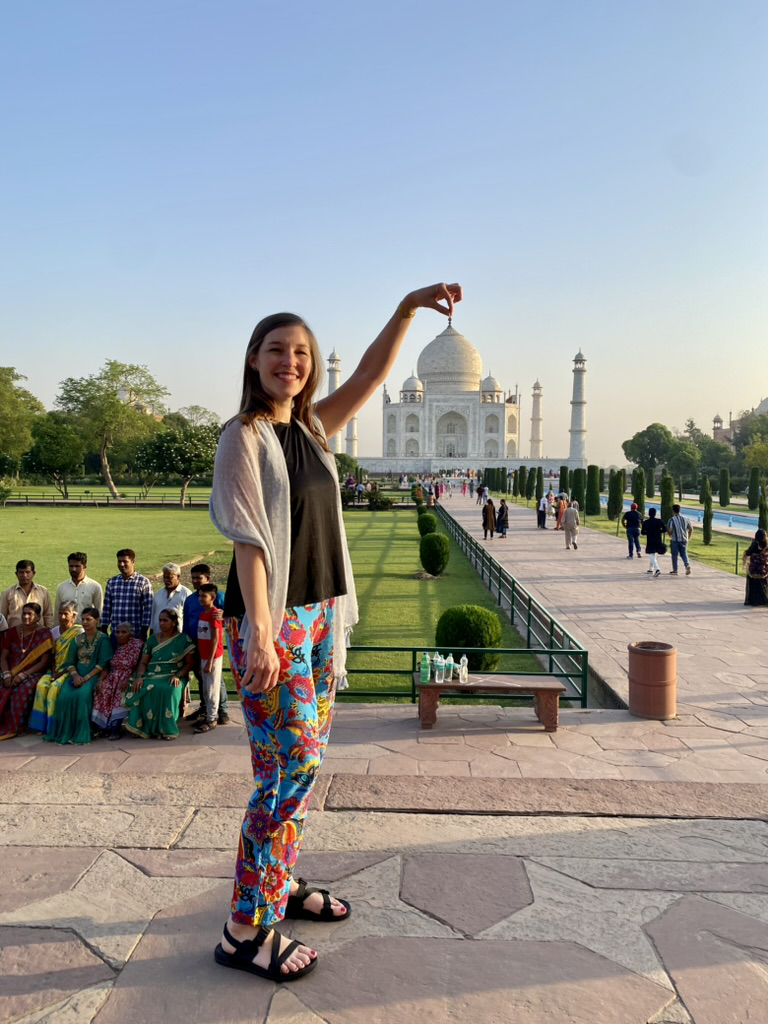
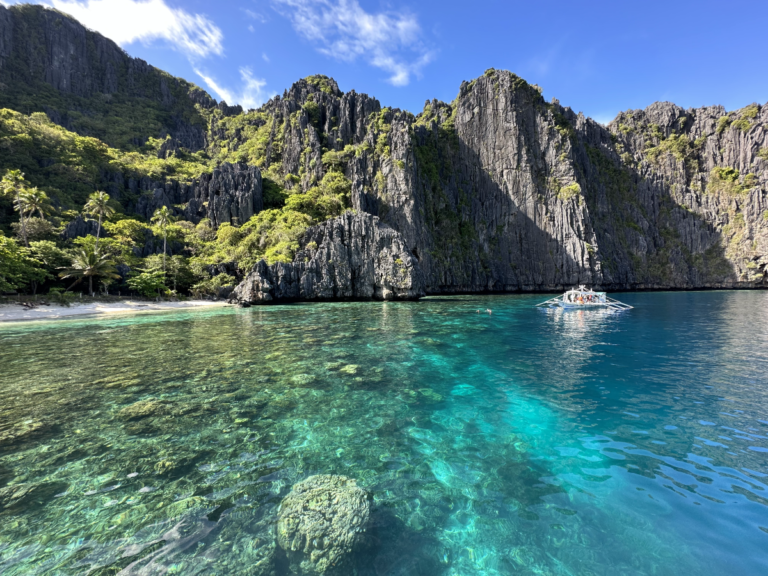
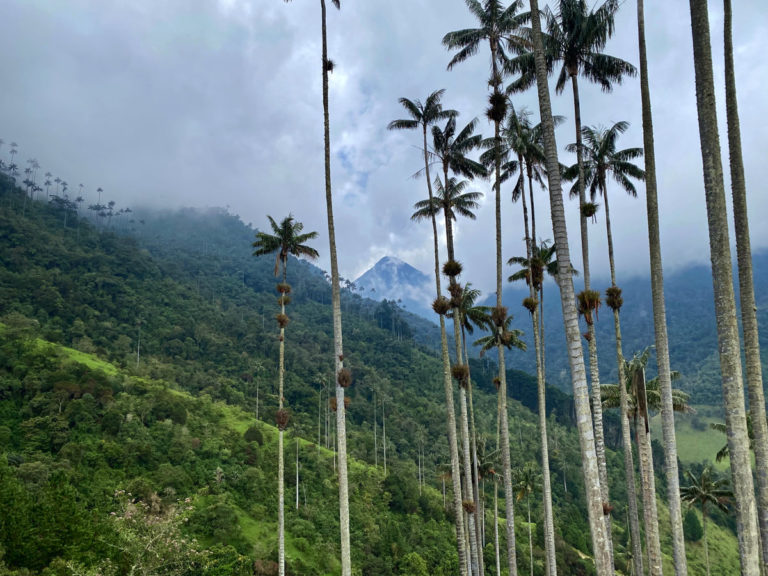
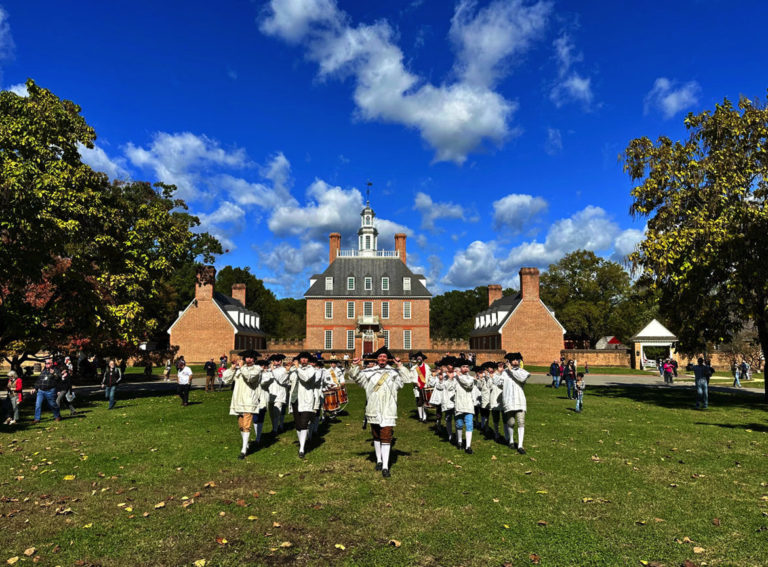


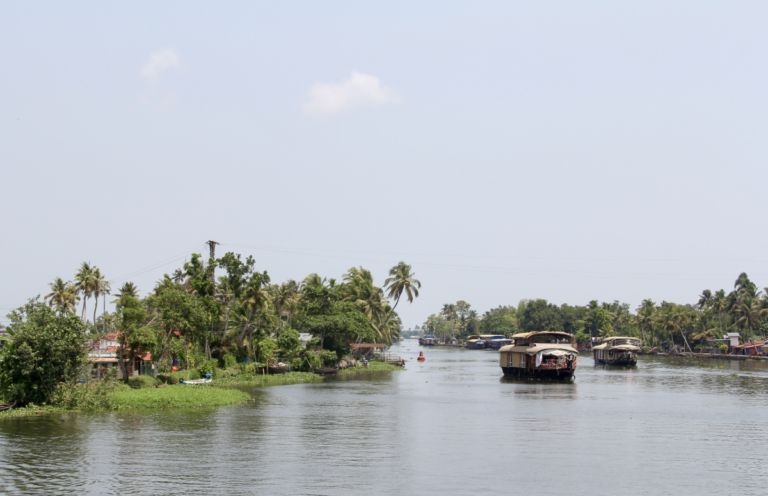
One Comment